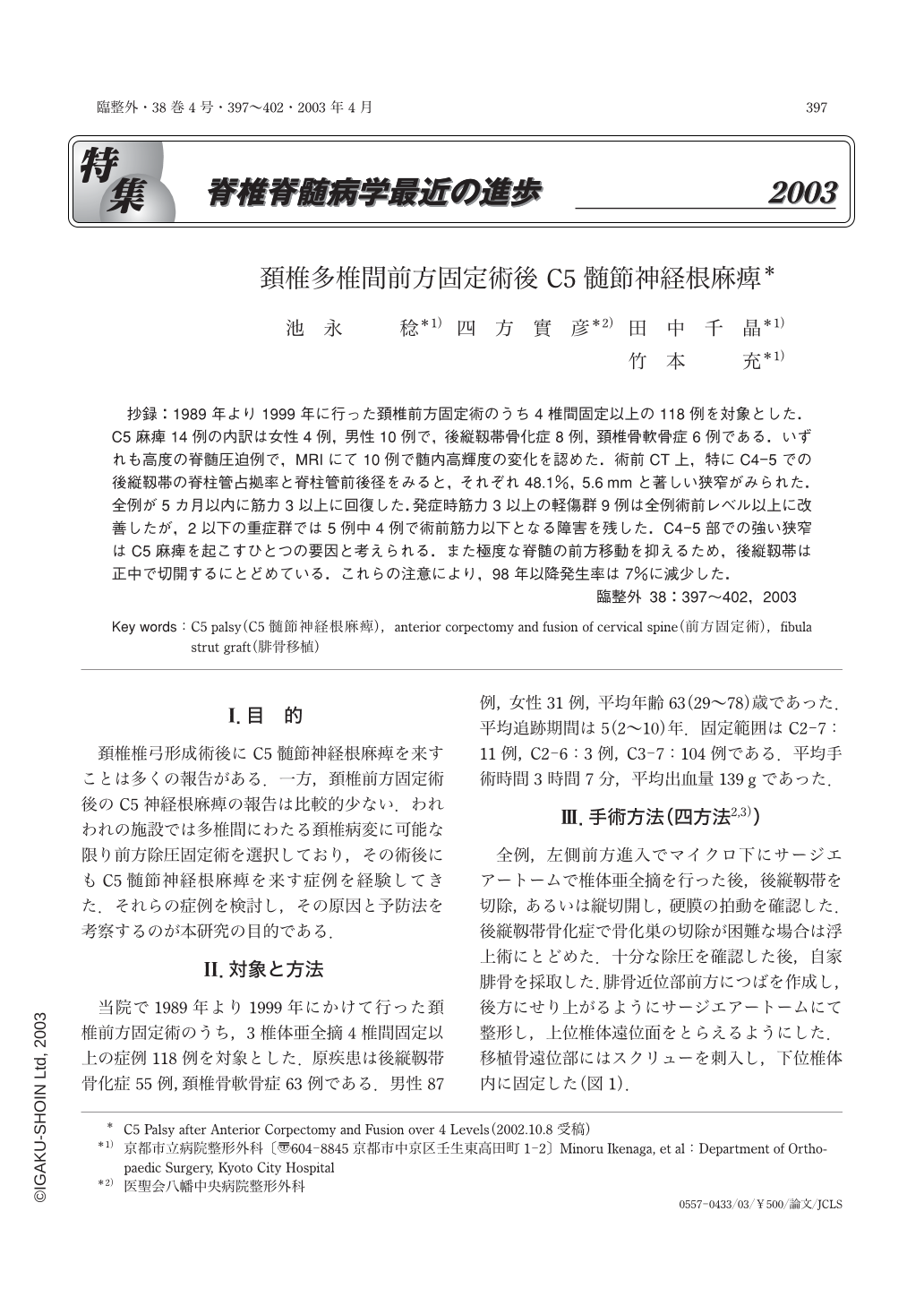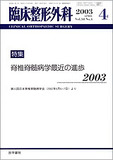Japanese
English
- 有料閲覧
- Abstract 文献概要
- 1ページ目 Look Inside
抄録:1989年より1999年に行った頚椎前方固定術のうち4椎間固定以上の118例を対象とした.C5麻痺14例の内訳は女性4例,男性10例で,後縦靱帯骨化症8例,頚椎骨軟骨症6例である.いずれも高度の脊髄圧迫例で,MRIにて10例で髄内高輝度の変化を認めた.術前CT上,特にC4-5での後縦靱帯の脊柱管占拠率と脊柱管前後径をみると,それぞれ48.1%,5.6mmと著しい狭窄がみられた.全例が5カ月以内に筋力3以上に回復した.発症時筋力3以上の軽傷群9例は全例術前レベル以上に改善したが,2以下の重症群では5例中4例で術前筋力以下となる障害を残した.C4-5部での強い狭窄はC5麻痺を起こすひとつの要因と考えられる.また極度な脊髄の前方移動を抑えるため,後縦靱帯は正中で切開するにとどめている.これらの注意により,98年以降発生率は7%に減少した.
Introduction:The purpose of this study was to investigate C5 palsy after anterior decompression and fusion of more than four levels with a fibula strut autograft.
Materials and Methods:The 118 patients treated in our clinic between 1989 and 1999 were included in the study, and 14 of them had C5 palsy after the intervention.
Surgical Procedure (Shikata's method):Partial corpectomy was performed under a microscope. The dura mater was exposed by complete or partial resection of the posterior longitudinal ligament. The harvested fibula was shaped to fit the cavity with a high-speed burr. The top of the graft was shaped to support the anteroinferior corner of the vertebral body above with a spike to prevent posterior migration. A screw hole to secure the graft was made in its distal portion. The hole was directed slightly fron the left to the right, and anteriorly to posteriorly. A cannulated screw 28 or 32mm long was used for fixation. The patient wore a halo-vest for 6 weeks.
Results:Mean operation time was 3 hours 7minutes. Mean blood loss was 139.6g. The preoperative, postoperative, and follow-up C2-7 angle was 11 degrees, 10 degrees, and 7 degrees, respectively (p>0.05). Shoulder or elbow weakness thought to be attributable to C5 nerve root paresis occurred in 14 patients, 10males and 4 females. The JOA score improved from 10.5 points preoperatively to 12.7 points postoperatively, and to 14.1 points at follow-up (p<0.05). MMT at the onset was 0 in 1 case, 1 in 2 cases, 2 in 2 cases, 3 in 7 cases, and 4 in 2 case. All patients recovered within 7 months. Postoperative CT or MRI scans revealed insufficient decompression in only 2 cases. Mild cases recovered to preoperative muscle power or better within 3months. In the 4 severe cases the muscle weakness was permanent.
Discussion and Conclusion:There have been only a few reports concerning C5 palsy after anterior cervical corpectomy and fusion. Several factors can affect the onset of the palsy, including preoperative severe stenosis, decompression technique, and postoperative tethering effect. Care must be paid to perform thorough decompression without damaging the root and to preventing excessive anterior cord shift. Accordingly, we now partially resect the PLL after decompression, not totally.

Copyright © 2003, Igaku-Shoin Ltd. All rights reserved.


